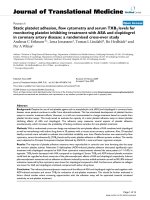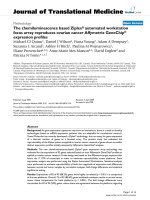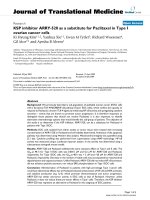báo cáo hóa học: " Burnout: need help?" potx
Bạn đang xem bản rút gọn của tài liệu. Xem và tải ngay bản đầy đủ của tài liệu tại đây (206.25 KB, 5 trang )
BioMed Central
Page 1 of 5
(page number not for citation purposes)
Journal of Occupational Medicine
and Toxicology
Open Access
Research
Burnout: need help?
Betul Gulalp*
1
, Ozgur Karcioglu
2
, Azade Sari
3
and Zikret Koseoglu
4
Address:
1
Department of Emergency Medicine, School Of Medicine, Baskent University, Adana, Turkey,
2
Department of Emergency Medicine,
Bakirkoy Dr. Sadi Konuk Research and Training Hospital, Bakirkoy, Istanbul, Turkey,
3
Department of Emergency Medicine, Cukurova State
Hospital, Adana, Turkey and
4
Department of Emergency Medicine, Numune Research and Training Hospital, Adana, Turkey
Email: Betul Gulalp* - ; Ozgur Karcioglu - ; Azade Sari - ;
Zikret Koseoglu -
* Corresponding author
Abstract
Background: Burnout syndrome is a psychological situation induced with working, especially in
high-risk parts of the hospitals that affects the physical and mental conditions of the staff. The aim
is to identify the characteristics of the staff related to Burnout Syndrome in the Emergency
Department (ED).
Methods: The study includes the Maslach Burnout Inventory and other new individual research
questions. The responders were the volunteers and comprised physicians, nurses, nurses' aides
from EDs of all urban state hospitals of Adana (43.3%). Burnout scores were analyzed with regard
to individual characteristics; supplementary work, marital status, the number of children,
occupation, salary, career satisfaction, satisfaction in private life. Mann-Whitney U test and
Kruskall-Wallis test were performed using SPSS 15.00.
Results: There were no relation between Burnout scores and supplementary work, marital status,
number of children, occupation, salary, private life satisfaction, except for career satisfaction.
Conclusion: Presence and severity of Burnout syndrome were linked to career satisfaction
without personal features and salaries. All branches of healthcare occupations in ED seem to have
been affected by Burnout Syndrome similarly.
Background
Burnout is a syndrome explained as serious emotional
depletion and behaviour with a poor adaptation at work
due to prolonged occupational stress [1]. It has three prin-
cipal components of emotional exhaustion, depersonali-
zation, and diminished feelings of personal
accomplishment. Emotional exhaustion is characterized
by personal feebleness. Lack of personal accomplishment
indicates the failure to achieve the individual aims and
depersonalisation is listlessness while working [1-3]. It is
a work-related syndrome and it is most likely to occur in
Emergency Departments (ED) that generally manage life
threatening conditions [3]. The staff have high stress due
to a myriad of reasons; including overcrowded depart-
ments, difficulty of cases, work schedules, disorganized
ED, deficient number of staff [4]. Burnout is accused to be
the main cause of impotent motivation. The specific risk
factors for ED staff have not been clearly established. The
aim of this study is to identify the relationship between
Burnout Syndrome in ED and individual characteristics of
the staff.
Published: 5 December 2008
Journal of Occupational Medicine and Toxicology 2008, 3:32 doi:10.1186/1745-6673-3-32
Received: 4 January 2008
Accepted: 5 December 2008
This article is available from: />© 2008 Gulalp et al; licensee BioMed Central Ltd.
This is an Open Access article distributed under the terms of the Creative Commons Attribution License ( />),
which permits unrestricted use, distribution, and reproduction in any medium, provided the original work is properly cited.
Journal of Occupational Medicine and Toxicology 2008, 3:32 />Page 2 of 5
(page number not for citation purposes)
Methods
Maslach Burnout individual-based study was conducted
in three state hospitals in one of the biggest cities of
Southern part of Turkey, Adana, between May 1 and 31,
2006. The inventories were given to voluntary participants
on their shifts to all groups after the information was
described. All healthcare workers in the ED were asked to
participate in the study which included a total of 77 emer-
gency doctors, 76 emergency nurses, 55 nurses' aide. The
self-report forms were advised to be filled alone during
the shifts and were collected by the directors of the depart-
ments. They were received via closed, without revealing
the name or any personal identification clue on the same
day. In this descriptive study, Burnout variables were stud-
ied with a total of 22 questions of Turkish version of
Maslach Burnout inventory [5,6]. There were 3 subgroups
that include 9 questions about emotional exhaustion, 5
questions were relevant to depersonalization and 8 ques-
tions involved in personal accomplishment. The partici-
pant gave a score to the questions between 0 (never) and
4 (always). The subjects were asked to respond to specific
questions relevant to eight individual issues: supplemen-
tary work, marital status, number of children, drug and
alcohol use, cigarette smoking (≥10/day), individual sug-
gestions about regular stress, management training and
professional psychiatric support of the staff against Burn-
out, occupation, salary, career satisfaction and finally, pri-
vate life satisfaction and family relations. The career
satisfaction of working in ED in every detail was asked to
the volunteers of the study. Private life satisfaction
included the general evaluation of all kinds of private life
and family relations by the participant. Supplementary
work meant extra working in a private health center in
addition to 160 hours/month for a regular job in ED of
the state hospital. As the acquired data were non-paramet-
ric, comparisons between two groups were performed
using Mann Whitney U test and comparisons among three
groups were analyzed with Kruskal Wallis test, SPSS 15.
The differences were accepted as significant when the p
value was below 0.05.
Results
The study included only EDs of the regional state hospi-
tals of the city, each with a daily volume of 600 to 800
patients. The participants were the physicians, nurses and
nurses'aide and have similar shift periods as 12 hours
(min 8-max 16). There were not any influence from com-
pany staff regarding negative effects while participants
were answering the questions. All of the three hospital are
currently up-dated, modernised and managed with posi-
tive support to the staff. There were not any public event
which may have markedly affected the overall workload
of the hospitals during the study. The study included 90
(43.3%) staff who had consented for recruitment from the
EDs of three state hospitals in Adana in May 2006. In
total, 38 (49.3%) emergency physicians, 40 (52.6%)
nurses, and 12 (21.8%) nurses' aide were enrolled. The
mean exhaustion score was 19.1 ± 9.1(0–36), while per-
sonal accomplishment score was 22.3 ± 5.9(8–32), and
depersonalization score was 7.8 ± 4.7(1–18). Tables 1 to
4 delineate Burnout scores regarding supplementary
work, married status, number of children, career satisfac-
tion, respectively. There were not any significant differ-
ences between physicians, nurses and nurse'aides
according to the occupation for emotional exhaustion,
personal accomplishment, depersonalization (p values
0.3, 0.2, 0.6, respectively). The significant difference val-
ues according to salaries for emotional exhaustion, per-
sonal accomplishment and depersonalization were 0.08,
0.5, 0.5, respectively. The significant difference values
according to private life satisfaction for emotional exhaus-
tion, personal accomplishment, depersonalization were
0.11, 0.6, 0.3, respectively. Beside them, 53% of the staff
refused to work in ED (n = 48). Forty-one percent of the
respondents were cigarette smoker (n = 37). The percent-
age of unanswered questions about drug and/or alcohol
Table 1: The relation between Burnout scores according to supplementary work are shown.
N Mean Median ss Min Max Line median. Mann-Whitney U p
Emotional exhaustion Yes 9 18,3 23 10,8 4 35 44,1 351,5 0,861
No 81 19,2 20 9,0 0 36 45,7
Personal accomplishment Yes 9 24,0 25 5,5 15 31 52,6 300,5 0,388
No 81 22,2 23 6,0 8 36 44,7
Depersonalization Yes 9 7,0 8 3,7 0 11 42,3 336 0,701
No 81 7,9 7 4,9 0 18 45,9
Journal of Occupational Medicine and Toxicology 2008, 3:32 />Page 3 of 5
(page number not for citation purposes)
consumption were 22.2% (n = 20), and 77.8% of the
answers were negative. Eigthy-four percent of the staff
accepted the regular stress management training and phy-
schological support against Burnout Syndrome (n = 76),
whereas 16% refused the suggestion (n = 14).
Discussion
Emergency staff are seriously under stress as various
patients with frequent shifts in a high risk of violence
directed towards them. In the EDs of state hospitals aprox-
imately 600 to 800 patients are managed and disposed in
24 hours. There is a twelve-hour shift system in the
recruited EDs, since longer working hours can be a serious
wearing factor [7]. Silva et al reported that the rate of emo-
tional exhaustion was 23%, depersonalization was
36.1%, personal accomplishment was 33.3% [8].
Gonzales et al mentioned the rates were as 59.7% for
emotional exhaustion, 36.1% for depersonalization,
31.2% for personal accomplishment as in their study [9].
We found that 53% of respondents demonstrated emo-
tional exhaustion, 39% had depersonalization, and 46%
reported lack of personal accomplishment. In this study
the ratio of lack of personal accomplishment compared to
the literature can be attributed to local circumstances of
this region. Keller and Koening reported that 53% of
emergency physicians planned to work at least ten years
longer, and only 24% of them foretold working for twenty
years [10]. Kalemoglu mentioned that the acquiescence to
work in ED for two years was 36%, more than three years
was 14% [11]. In this study 53% of the staff refused to
work in ED anymore. The recent reports attributed this
phenomenon to overcrowdedness in ED, disorganization,
understaffing, agressive behaviors of the patients, and
finally, low income with personal and environmental
characteristics. Howsoever, beside the stress in depart-
ment, private life satisfaction with family relations can be
affected on Burnout Syndrome for ED staff [4]. Kalemoglu
et al and Whitley et al [11,12] reported that single ED phy-
sicians showed depression findings more than married
ones. Taycan found that emotional exhaustion in singles
was more common than that in married ones [13]. How-
ever, in our study there were no relations between Burn-
out scores and having supplementary work, marital status,
number of children, private life satisfaction. These dem-
onstrated that the other factors as working schedules,
organization, relations within the team, behavioral char-
acters of the public of the region could be the stronger pre-
dictive factors for Burnout of the ED staff due to career
satisfaction and clarify with subsequent studies. Although
emergency staff were not aware of Burnout before this
study (n = 90, 100 %), there was a high percentage of
acceptance about regular professional psychiatric support
and training (n = 76, 84.4%). In a study, substance addic-
tion was found to be more common among the residents
in the ED when compared to the other departments [14].
In the present study, some of the participants refused to
answer the question about using any psychiatric drugs
and/or alcohol regularly (n = 20, 22.2%), and it was
deemed an unexpected result. Five of them (5.5%)
reported to use alcohol, while two others were using anti-
depressant drugs regularly. There were some limitations in
this study. The study included nearly half of the staff of
Table 2: The relation between Burnout scores and marital status are demonstrated.
N Mean Median ss Min Max Line median Kruskall-Wallis H SD p
Emotional exhaustion M 65 19,0 20 9,3 0 36 45,2 0,593 2 0,743
W 7 17,1 22 8,8 4 27 40,0
U 18 20,5 21 9,0 5 36 48,7
Personal accomplishment M 65 22,8 23 6,0 11 36 47,0 0,751 2 0,686
W 7 22,0 23 4,7 18 31 41,6
U 18 21,1 21,5 6,2 8 31 41,7
Depersonalization M 65 7,5 7 4,5 0 17 44,2 0,915 2 0,632
W7 7,7 5 5,80 17 43,9
U 18 9,0 7,5 5,2 1 18 50,8
M = Married, W = Widowed, U = Unmarried.
Journal of Occupational Medicine and Toxicology 2008, 3:32 />Page 4 of 5
(page number not for citation purposes)
EDs. The subscores range were wide as the experiences in
ED of the staff could be different. The report comprised
only physicians, nurses and nurses' aide; excluding secu-
rity, secretary and other ED staff.
Conclusion
This study reported that individual properties of staff and
even salaries were not related with Burnout. New studies
could focus on career satisfaction probably with organiza-
tion and management methods on Burnout Syndrome to
develop new strategies against Burnout Syndrome in ED.
Competing interests
The authors declare that they have no competing interests.
Authors' contributions
BG designed the study, collected data, carried out the stat-
ics and wrote the manuscript, OK reviewed and edited the
manuscript, AS and ZK conducted the research and col-
lected individual data in their institutions. All authors
read and approved the final manuscript.
Acknowledgements
Thanks to esteemable Dr. Turgut Arpaci from Adana Health Management
and Dr. Mehmet Yagci, Director of Adana State Hospital for the support
given in this study.
References
1. Castelo-Branco C, Figueras F, Eixarch E, Quereda F, Cancelo MJ,
Gonzalez S, Balasch J: Stress symptoms and burnout in obstet-
ric and gynaecology residents. BJOG: An international journal of
obstetrics and gynaecology 2007, 114:94-98.
Table 3: The relation between Burnout scores and the number of children are shown.
N Mean Median ss Min Max Line Medium Kruskall-Wallis SD p
Emotional exhaustion 0 11 19,9 22 6,4 7 28 38,7 0,427 2 0,808
1 28 19,1 20,5 9,2 0 35 37,7
2+ children 33 18,2 19 10,1 4 36 34,8
Personal accomplishment 0 11 21,9 21 5,6 11 32 34,5 1,055 2 0,590
1 28 22,1 23 5,1 15 32 34,1
2+children 33 23,5 24 6,6 12 36 39,2
Depersonalization 0 11 6,6 8 3,6 0 12 33,9 0,228 2 0,892
1 28 7,7 6 4,7 0 17 37,4
2+children 33 7,6 6 5,0 0 17 36,6
Table 4: The relation between Burnout scores and career satisfaction are shown.
N Mean Median ss Minimum Maximum Line Medium. Mann-Whitney U P
Emotional exhaustion Yes 38 15,1 14,5 8,1 4 35 23,1 137 0,000
No 22 26,0 25 6,6 13 36 43,3
Personal accomplisment Yes 38 24,2 24,5 5,7 12 36 35,2 241 0,006
No 22 19,5 19 5,9 8 32 22,5
Depersonalization Yes 38 6,1 6 4,3 0 16 24,5 190 0,000
No 22 10,3 10 4,0 2 16 40,9
Publish with BioMed Central and every
scientist can read your work free of charge
"BioMed Central will be the most significant development for
disseminating the results of biomedical research in our lifetime."
Sir Paul Nurse, Cancer Research UK
Your research papers will be:
available free of charge to the entire biomedical community
peer reviewed and published immediately upon acceptance
cited in PubMed and archived on PubMed Central
yours — you keep the copyright
Submit your manuscript here:
/>BioMedcentral
Journal of Occupational Medicine and Toxicology 2008, 3:32 />Page 5 of 5
(page number not for citation purposes)
2. Lederer W, Kinzl JF, Trefalt E, Traweger C, Benzer A: Significance
of working conditions on burnout in anesthetists. Acta Anaes-
thesiologica Scandinavica 2006, 50:58-63.
3. Sameer S, Chopra AM, Sotile Wayne M, Sotile Mary O: Physician
Burnout. J Am Med Assoc 2004, 5:633.
4. Cevik AA, Holliman CJ, Yanturali S: Emergency physicians and
burn out syndrome. Ulus Travma Acil Cerrahi Derg 2003,
9(2):85-89.
5. Ozdemir AK, Kýlýc E, Ozturk M, Ozdemir D, Ozturk M, Sumer H:
The evaluation of burnout scale of academic staff in three
years in dental medicine school of Cumhuriyet University. J
Dental Med Cumhuriyet University 2003, 6:14-18.
6. Maslach C, Schaufeli WB: Job burnout. Annu Rev Psychol 2001,
52:397-422.
7. Thomas H Jr, Schwartz E, Whitehead C: Eight-versus 12-hours
shifts: implications for emergency physicians. Ann Emerg Med
1994, 23:1096-1100.
8. Silva MH, Daniel VE, Perez UA: A study of the burnout syndrome
in medical personel of a general hospital. Actas Espanolas De
Psiquiatria 1999, 27:310-20.
9. Gonzalez PR, Gonzalez SJF: The prevalence of the burnout syn-
drome or professional exhaustion in primary care physi-
cians. Aten Primaria 1998, 22(9):580-584.
10. Keller KL, Koening WJ: Management of stress and prevention
of Burnout in emergency physicians. Ann Emerg Med 1989,
18:42-47.
11. Kalemoglu M, Keskin O: Evaluation of stress factors and burn-
out in the emergency department. Ulus Travma Derg 2002,
8(4):215-219.
12. Whitley TW, Gallery ME, Allison EJ Jr, Revicki DA: Factors associ-
ated with stress among emergency medicine residents. Ann
Emerg Med 1989, 18:1157-1161.
13. Taycan O, Kutlu L, Cimen S, Aydýn N: Relation between sociode-
mographic characteristics depression and burnout levels of
nurse working in university hospital.
Anatolian J Psychiatry 2006,
7:100-108.
14. Hughes PH, Baldwin DC, Sheehan DV, Conard S, Storr CL: Resident
physician substance use by specialty. Am J Psychiatry 1992,
149(10):1348-1354.









